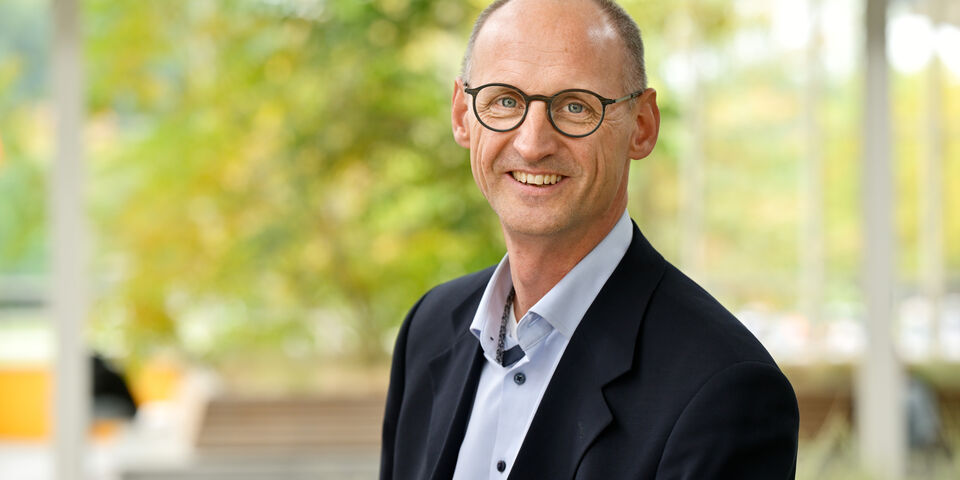Robert van Dongen would love to teach his students outdoors
During MomenTUm, Robert van Dongen was named the best lecturer in the TU/e master’s programs. His field within Built Environment is the city, with a focus on greenery and the psychology of urban spaces. “I try to be a facilitator for students—they have to do the learning themselves.”
At the entrance of Vertigo, bachelor’s student Akram Potmis is tidying up materials from the BouwBedrijvenDagen event. When asked if he knows lecturer Robert van Dongen, he smiles: “Yes, he supervised me in two projects. I think he’s a great teacher because he tries to see things from my perspective. Many teachers know a lot but mainly express their own knowledge. The way Robert van Dongen teaches is more fun and much more educational.”
Van Dongen, a lecturer at the Department of the Built Environment, works in the Urban Systems and Real Estate unit within the Urban Planning and Transportation research group. “My main focus is on environmental psychology and greenery. It’s literally right outside our door. What I teach in class can be beautifully observed outdoors if you pay attention.”
What he finds especially rewarding: “Right in front of us—between the campus, the train station, and the football stadium—lies an area that will undergo enormous transformation over the next 25 to 30 years. That so-called Knoop XL project covers my entire field of study.” The municipality of Eindhoven, he explains, is looking for creative and cheerful ideas from Built Environment students for this temporary (yet thirty-year-long) situation: “How can the area remain usable, accessible, and pleasant for residents?”
Teaching
Van Dongen started his architecture studies at TU/e in 1994, later working for a regional government and then a university of applied sciences in Breda. In 2012, he returned to TU/e to pursue a PhD with an NWO grant and successfully defended his dissertation in 2023. Over time, he began teaching more days per week at Urban Systems and Real Estate. He now teaches from first year through graduation, coaches at the Honors Academy, and maintains ties with the municipality of Eindhoven.
In 2025, he received TU/e's award for best master’s teacher. He is praised by students for his accessibility and his campus excursions that make theoretical concepts tangible and easy to grasp. “I only found out at the last moment,” he recalls. “TU/e had asked me and the other nominees to bring guests and attend MomenTUm from the VIP section. The day was full of healthy excitement and a lot of fun.”
Interaction
Van Dongen knows that students typically remember only about ten percent of what lecturers say in traditional lectures. “That’s why I try to make what I tell them as recognizable as possible in real life—using many different methods. I focus on the students’ needs: what questions do they have? And then I build from there.”
A great example is Het Café, where he invites first-year students twice during a lecture series. “If they like, they can stay after class to discuss anything they want. An example is student housing. It’s a big success—I’ve already extended it to 45 minutes. Out of roughly 300 students, about 30 stay each time.”
Stepping outside
Van Dongen also organizes other voluntary learning moments through mini-excursions. “Students can join visits to the Digital Twin Lab or to the construction site just outside campus, behind the Dommel tunnel. I also had two master’s students lead a biodiversity-themed campus walk for first-years.” He has personally taken students to Eindhoven’s city center to show them the traces of history still visible in the modern urban landscape.
“In the master’s course Smart Healthy Urban Environments, I connect the theory of smart health—greenery in cities as a factor for well-being—to practice using VR headsets. These are tools for participation in urban planning. With them, you can easily show how an area would look with or without trees. Students learn how to involve citizens in thinking about their city’s design.”
Funding ideas
The award also came with a €15,000 prize to invest in educational innovation. Van Dongen already has several ideas, including one particularly exciting project: an outdoor classroom. “I imagine an amphitheater, nicely designed—maybe even with a drawing board—but definitely in the open air. It would be great to involve students in the design process. Consider acoustics, lighting, shelter, and durability. It could become a design competition or an assignment for the Bouwkundewinkel.”
He’s aware that realizing such a classroom won’t be easy: “It requires permits, Real Estate has to get on board, and €15,000 probably won’t cover everything.”
Nature
An outdoor classroom has both pros and cons. “Of course, it depends on the weather, so you can’t use it year-round. But being in a natural setting makes learning more effective,” says the lecturer who focusses on Environmental Psychology and green urban spaces. “Green environments are good for the human brain—you can focus better after spending time in nature. Plus, being outdoors in a natural setting reduces stress.”
Van Dongen clearly has his students’ best interests at heart. “They get out of bed to come to class—from near and far—they pay tuition and genuinely want to learn. It’s our job to foster a scientific mindset in them.” His advice for fellow lecturers: “Be genuine and enjoy what you do and teach. If you speak passionately about what fascinates you, it resonates more with students. But above all, do what fits you.”
For Van Dongen, that means first finding out what the student needs—and guiding them from there. Student Akram Potmis can confirm that.
This article was translated using AI-assisted tools and reviewed by an editor.


Discussion